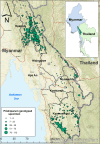Molecular markers of artemisinin resistance during falciparum malaria elimination in Eastern Myanmar
- PMID: 38720269
- PMCID: PMC11078751
- DOI: 10.1186/s12936-024-04955-6
Molecular markers of artemisinin resistance during falciparum malaria elimination in Eastern Myanmar
Abstract
Background: Artemisinin resistance in Plasmodium falciparum threatens global malaria elimination efforts. To contain and then eliminate artemisinin resistance in Eastern Myanmar a network of community-based malaria posts was instituted and targeted mass drug administration (MDA) with dihydroartemisinin-piperaquine (three rounds at monthly intervals) was conducted. The prevalence of artemisinin resistance during the elimination campaign (2013-2019) was characterized.
Methods: Throughout the six-year campaign Plasmodium falciparum positive blood samples from symptomatic patients and from cross-sectional surveys were genotyped for mutations in kelch-13-a molecular marker of artemisinin resistance.
Result: The program resulted in near elimination of falciparum malaria. Of 5162 P. falciparum positive blood samples genotyped, 3281 (63.6%) had K13 mutations. The prevalence of K13 mutations was 73.9% in 2013 and 64.4% in 2019. Overall, there was a small but significant decline in the proportion of K13 mutants (p < 0.001). In the MDA villages there was no significant change in the K13 proportions before and after MDA. The distribution of different K13 mutations changed substantially; F446I and P441L mutations increased in both MDA and non-MDA villages, while most other K13 mutations decreased. The proportion of C580Y mutations fell from 9.2% (43/467) before MDA to 2.3% (19/813) after MDA (p < 0.001). Similar changes occurred in the 487 villages where MDA was not conducted.
Conclusion: The malaria elimination program in Kayin state, eastern Myanmar, led to a substantial reduction in falciparum malaria. Despite the intense use of artemisinin-based combination therapies, both in treatment and MDA, this did not select for artemisinin resistance.
Keywords: P. falciparum; Artemisinin resistance; Kelch13; Malaria elimination; Mass drug administration.
© 2024. The Author(s).
Conflict of interest statement
No competing interests were disclosed.
Figures






References
-
- Phyo AP, Ashley EA, Anderson TJC, Bozdech Z, Carrara VI, Sriprawat K, et al. Declining efficacy of artemisinin combination therapy against P. falciparum malaria on the Thai-Myanmar border (2003–2013): the role of parasite genetic factors. Clin Infect Dis. 2016;63(6):784–91. doi: 10.1093/cid/ciw388. - DOI - PMC - PubMed
-
- Amato R, Lim P, Miotto O, Amaratunga C, Dek D, Pearson RD, et al. Genetic markers associated with dihydroartemisinin–piperaquine failure in Plasmodium falciparum malaria in Cambodia: a genotype–phenotype association study. Lancet Infect Dis. 2017;17(2):164–173. doi: 10.1016/S1473-3099(16)30409-1. - DOI - PMC - PubMed
MeSH terms
Substances
Grants and funding
LinkOut - more resources
Full Text Sources
Research Materials

